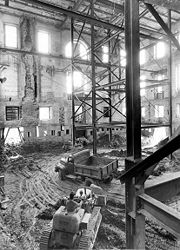
Renovation
Encyclopedia

Process
The process of a renovation, however complex, can usually be broken down into several processes. They are:- PlanningPlanningPlanning in organizations and public policy is both the organizational process of creating and maintaining a plan; and the psychological process of thinking about the activities required to create a desired goal on some scale. As such, it is a fundamental property of intelligent behavior...
- EngineeringEngineeringEngineering is the discipline, art, skill and profession of acquiring and applying scientific, mathematical, economic, social, and practical knowledge, in order to design and build structures, machines, devices, systems, materials and processes that safely realize improvements to the lives of...
- Structural repair
- Rebuilding
- Finishes
Wood and renovations
Wood is versatile and flexible, making it the easiest construction material for renovations. Wood buildings can be redesigned to suit changing needs, whether this involves adding a new room or moving a window or door. Few homeowner or professional remodelers have the skill and equipment needed to alter steel-frame or concrete structures.Forest certification verifies that wood products are from well-managed forests. Most certification programs have on-line search options so consumers can find certified products – the Certification Canada includes a search option for all the certification programs used in Canada,
In North America, most structures are demolished because of external forces such as zoning changes and rising land values. As well, buildings which no longer serve the functional needs of the occupants and which cannot be modified are subject to demolition. Very few buildings are demolished because of structural degradation. (Cite the Athena Study of demolitions in Minnesota.)
The Athena Institute surveyed 227 commercial and residential buildings demolished in St. Paul, Minnesota, from 2000 to mid-2003. Thirty percent of the buildings were less than 50 years old, and 6% were less than 25 years old. The four biggest reasons for demolition were “Area redevelopment” (35%), “Building’s physical condition” (31%), “Not suitable for anticipated use” (22%) and “Fire damage” (7%). Lack of maintenance was cited as the specific problem for 54 of the 70 buildings where physical condition was given as the reason for demolition.

